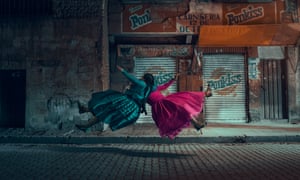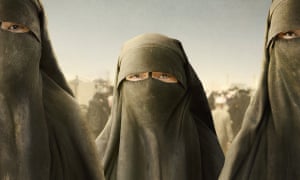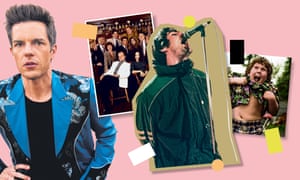Bolivia’s indigenous female wrestlers mid-flight: Todd Antony’s best photograph
‘These women wrestle for their mental and physical health – and to stick two fingers up at a male wrestling culture. Capturing them mid-flight was tricky’

Bolivia’s cholitas luchadoras began wrestling in the early 2000s. The women, indigenous Aymara Indians who have traditionally been marginalised and oppressed, took to Mexican-style lucha libre wrestling for mental and physical health – and to stick two fingers up to a culture where wrestling was strictly a male preserve. For many it was also a means of escaping domestic violence. Their choreographed fights in the ring became a dramatisation of day-to-day struggles, all the while adorned in their traditional dress of layered skirts, petticoats and embroidered shawls. Their name, too, subverts and reclaims a term, cholita, that has often been used to demean. But there was also a social and recreational aspect to the wrestling matches that are staged as entertainment, and have grown over the years. Today it’s become a living for many of them, with their fights drawing huge crowds of local people and tourists.
For my personal projects I seek out ordinary people that lead extraordinary lives. I came across the cholitas luchadoras when I was researching another (unconnected) project in La Paz, the Cholitas Escaladoras Bolivianas, AKA the climbing cholitas. The wrestlers are in El Alto, a suburb of La Paz that sits high on a plateau 1,500m above the main city. The houses of the town seem to cascade down the steep cliffs into La Paz below and the mountains of the Andes are ever present. We spent our first few nights driving around looking for cool locations that would showcase the women – I knew I wanted to photograph them outside the ring and make the landscape part of the images. The float and bounce of their traditional dresses is an integral part of the visual impact of the wrestling, and I drew inspiration from the South American literary tradition of magic realism in how I portrayed the fighters mid-air, mid-flight, giving the images a dream-like quality.
Ponkiss is a local soda of sorts. I know it almost looks like a set but it’s a street in El Alto. I had set up lighting to freeze the action, but I didn’t stage-manage the costumes – this is what they wear when in the ring and just another part of what makes them so unique, although I did place the various women in settings according to what colours would work better together. I love how the beautiful teal colours from the light in the window above are reflected in the colour of the dress. We also lit the background with the headlights from our production vehicle parked just out of frame – you can see that low light in the picture, raking from right to left, highlighting the wrestlers and lifting them out from the background. From a technical point of view it was a very tricky shot. I’m not going to tell you exactly how it was done, but I promise there were no wires, nothing like that. What you are seeing is them mid-flight. We kept experimenting to see which moves created the most dynamic shapes and allowed the dresses to flow and billow. We must have done 30 takes for each image but the women never batted an eye despite the physical toll. They’re incredible.
The wrestling matches might be staged – with the técnicos (the good guys) versus the rudos (the bad guys), but that doesn’t make them any less physically challenging. In some matches the women also take on men – guys often twice their size – and hurl them over their shoulders. But, however much it’s for show, the ring is still a sheet of plywood on top of stainless steel struts; when you hit it, it still hurts, you still bleed.
I’ve just returned from Sierra Leone where I was photographing amputee football teams – men who have lost legs during the civil war. Most of the imagery we’re used to digesting from Africa is documentary in style, or in bleached, brown tones, which is frequently counter to the vibrancy of colour there. I try to challenge these visual tropes by consciously shooting against them, especially by using lighting in settings you wouldn’t expect. I arrived in Sierra Leone with 10 cases of equipment, and for the Climbing Cholitas series we carried battery-powered studio flash units up to 5,000m to shoot the climbers in a way not ordinarily seen in mountaineering photography.
If possible I want these photos to provide some sort of tangible benefit for their subjects. I don’t want to rock up, take a bunch of pictures and leave again. I’m using the images from the Sierra Leone footballers to drive a GoFundMe I’ve set up to purchase crutches for the players, as they are prohibitively expensive there. And wherever possible I spend time with the people I’m shooting. Just hang out and chat. I owe it to them to produce images that do them justice.
Born: New Zealand, 1975.
Trained: Photographer’s assistant.
Influences: Edward Burtynsky, Gregory Crewdson, Nick Brandt – This Empty World.
High point: “That I get to do what I love as my job – travelling the world meeting amazing people and sharing moments with them.”
Low point: “I’d shot an ad campaign in India with an amazing all-female motorcycling group. Just a few weeks later one of the main women in the group died in a motorway accident. She had a young daughter and this amazing energy and personality that shone through and had resonated with all of us working on the project.”
Top tip: “Shoot what excites you and makes something tick inside you. If it doesn’t excite you, chances are what you’re producing won’t connect with as many people as it could.”
See more at toddantony.com.



